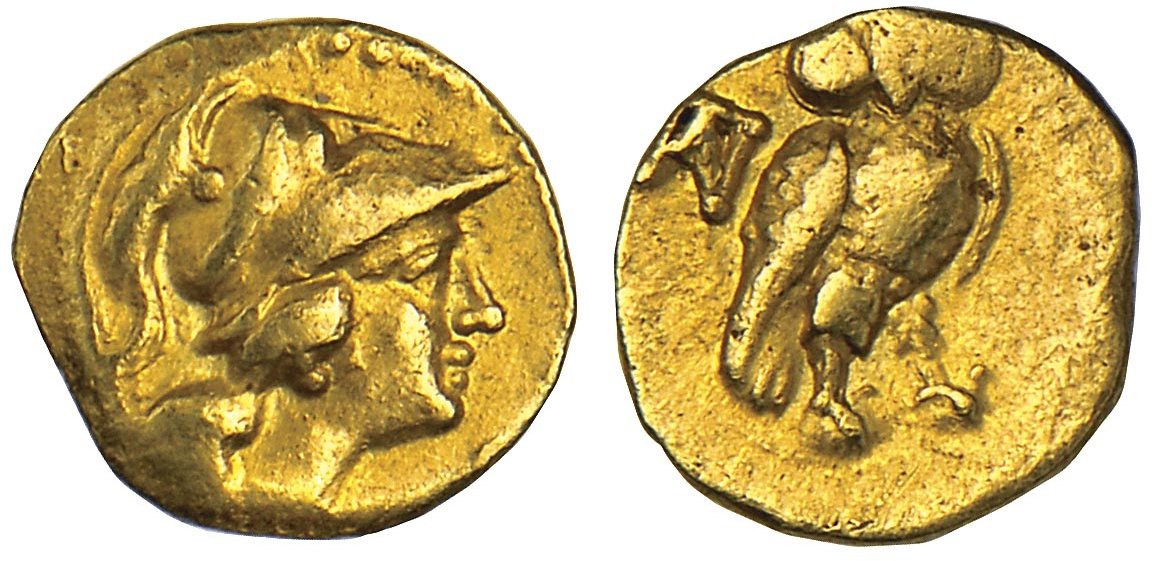Taras, gold, ogdoemoria (276-272 BCE)
From SILVER
276 BCE - 272 BCE Gold 508 kg
Description
| ObverseInscription or printing placed on the obverse.: | Helmeted head of Athena r. |
| ReverseInscription or printing placed on the reverse.: | AΠΟΛ (Greek).Owl standing r. |
Mint and issuing power
| MintIdentifies the place of manufacture or issue of a numismatic object.: | Taras | Ancient regionAncient region.: | Calabria | Modern countryModern country: Italy | AuthorityIdentifies the issuing power. The authority can be "pretended" when the name or the portrait of X is on the coin but he/she was not the issuing power. It can also be "uncertain" when there is no mention of X on the coin but he/she was the issuing power according to the historical sources: | Pyrrhus (general, Aeacid king of Molossians, Macedonia and Epirus, 306-272 BC) |
Chronology
| FromIdentifies the initial date in a range assigned in a numismatic context. | 276 BCE | toIdentifies the final date in a range assigned in a numismatic context.. | 272 BCE | PeriodTime period of the numismatic object.: Hellenistic 323-30 BC |
Physical description
| MetalThe physical material (usually metal) from which an object is made.: | Gold |
Median weightMedian of the weights of numismatic objects (in grams). in grams | 1.05 | DenominationTerm indicating the value of a numismatic object. Examples: tetradrachm, chalkous, denarius.: | hemitetarte |
StandardStandard.: | Attic |
Image

S849 Taras ogdoemoria.jpg [1]
References
| Die study referencePublication of the study: | Fischer-Bossert 19991Fischer-Bossert 1999, p. 373, G69-70 | ||
| Coin series referenceReference to coin series study: | |||
| Coin series web referenceCoin series web references: | |||
Obverse dies distribution
| FrequencyFrequency of specimen in distribution. ᵖ | Number of obversesNumber of obverse dies. ᵖ (o) | % (o) | Number of coinsNumber of coins. (n) | % (n) | Die nameName(s) of the die(s). |
| 1 | 1 | 50 | 1 | 14.29 | 57 |
| 6 | 1 | 50 | 6 | 85.71 | 56 |
| Total | 2 of 2 | 100 | 7 of 7 | 100 |
Reverse dies distribution
| FrequencyFrequency of specimen in distribution. ᵖ | Number of reverse diesNumber of reverse dies. (r) | % (r) | Number of coinsNumber of coins. (n) | % (n) | Die nameName(s) of the die(s). |
| 1 | 1 | 50 | 1 | 14.29 | 70 |
| 6 | 1 | 50 | 6 | 85.71 | 69 |
| Total | 2 of 2 | 100 | 7 of 7 | 100 |
Quantification
| Number of obversesNumber of obverse dies. ᵖ (o) | 2 | Number of singletons (o1)The number of singleton coins. ᵖ | 1 |
| Number of reverse diesNumber of reverse dies. (r) | 2 | Number of coinsNumber of coins. (n) | 7 |
| Coins per obverse dieNumber of coins per obverse die. (n/o) | 3.5 | Coins per reverse dieNumber of coins per reverse die. (n/r) | 3.5 |
| Reverse per obverse ratioRatio of obverse dies divided by reverse dies. (r/o) | 1 | Percentage of singletons (o1)number of coins (n) divided by the number of singletons (o1) ᵖ | 50 % |
| Original number of dies (O) (Carter 1983 formula)The estimation of the number of coins according to Carter 1983 ᵖ | 2.42 | Coins struck if 20,000 as average productivity per dieCoins made if the average productivity for obverses (according to Carter) is 20,000. ᵖ | 48,400 |
| Original number of dies (O) (Esty 2011 formula)The estimation of the number of coins according to the singleton formula in Esty 2011 ᵖ (O) | 2.8 | Survival rate if 20,000 as average productivity per dieSurvival rate if average productivity is 20,000. ᵖ | 0.00014 |
| Coverage (o = % of O) (Esty 1984 formula)Esty 1984 - coverage (% of O) ᵖ (o = % of O) | 85.71% | Die productivity if survival rate 1/2,000Average productivity if survival rate is 1/2,000. ᵖ | 5,785.12 |
| Weight of silver (in kg) if 20,000 coins per die (O = Carter formula)Carter 1983 * Median weight * 20000 (*10 if gold or electrum) ᵖ | 508 kg <br /> 508 kg | Die productivity if survival rate 1/5,000Average productivity if survival rate is 1/5,000. ᵖ | 14,462.81 |
Remarks
Most likely one single workstation Likely military
References
- ^ Fischer-Bossert, Wolfgang (1999), Chronologie der Didrachmenprägung von Tarent, 510-280 v. Chr., Berlin, De Gruyter, xvii, 495 p., [84] pl.